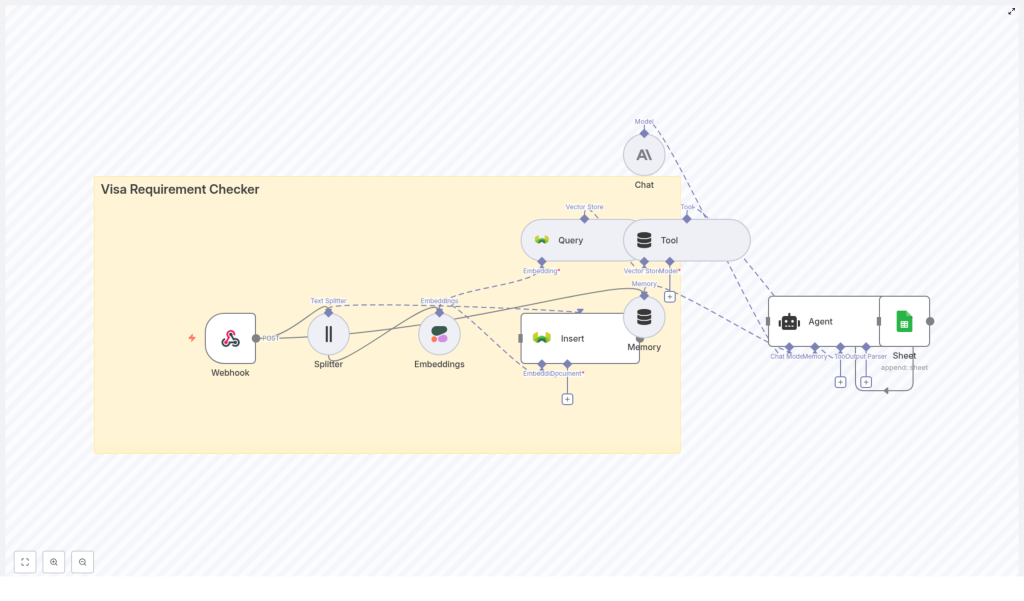Build a Visa Requirement Checker with n8n, Weaviate and Embeddings
Travel teams and product owners can automate visa guidance by combining no-code automation with vector search and LLMs. In this tutorial you’ll learn how the “Visa Requirement Checker” workflow works, how to wire up every node in n8n, and best practices to deploy a reliable, privacy-aware visa lookup service.
Why use vector search and embeddings for visa guidance?
Visa rules are text-heavy, change frequently, and often require approximate matching (e.g., country names, passport types, or special cases). Traditional keyword matching fails when the user phrasing varies. Using embeddings and a vector store (like Weaviate) lets you find semantically similar policy snippets, then use an LLM to synthesize a clear, actionable response.
Key benefits
- Semantic search over policy documents — find relevant passages even when wording differs.
- Updatable knowledge store — insert new guidance or updates without retraining.
- Fast, scalable inference when combined with an LLM chat agent for final output.
Architecture overview
The provided template implements this flow in n8n. High-level components:
- Webhook — Accepts a POST request from a front-end or API consumer.
- Text Splitter — Breaks long policy docs into smaller chunks for embedding.
- Embeddings — Uses Cohere (or another provider) to convert text into vectors.
- Weaviate Insert & Query — Stores chunk vectors and retrieves similar passages.
- Tool + Agent — A chat agent uses retrieved passages, memory, and an LLM (Anthropic in the template) to craft an answer.
- Memory — Short-term buffer to keep context across interactions.
- Google Sheets — Optional logging of requests and results for analytics or audit trail.
Node-by-node breakdown (n8n workflow)
1) Webhook
Set up an HTTP POST endpoint named /visa_requirement_checker. This is the entry point where your UI or API sends queries like: “Does a US passport holder need a visa for Brazil for tourism?”
2) Text Splitter
Policy documents can be long. Split them into overlapping chunks (the template uses chunkSize=400 and chunkOverlap=40 characters). Overlap helps maintain semantic continuity for embeddings.
3) Embeddings
Use Cohere or another embeddings provider to transform each chunk into a dense vector. The template sets the model to default — in production you may choose a specific embedding model tuned for semantic retrieval.
4) Insert (Weaviate vector store)
Store each embedded chunk along with metadata (country, document ID, last-updated timestamp, and original text). Use a consistent index name such as visa_requirement_checker so queries target the correct dataset.
5) Query + Tool
When a user submits a question, convert the query into an embedding and query Weaviate for nearest neighbors. The returned passages are provided to the Agent via a Tool node, enabling the LLM to reference real policy snippets when generating the final answer.
6) Memory & Chat
A short-window memory node stores recent interactions to support follow-up questions (e.g., user asks “What about work visas?” after an initial tourism query). The Chat node integrates with an LLM (the template uses Anthropic) to craft the conversational reply.
7) Agent & Sheet
The Agent orchestration node runs the final prompt logic and produces the output. The workflow appends a record to Google Sheets for logging: user question, matched passages, LLM response, and timestamp. This aids auditing and ongoing data quality checks.
Implementation tips
Metadata design
Store metadata with each vector to allow filtered search (e.g., filter by origin country or document date). Example metadata keys: country, visa_type, document_url, last_updated.
Chunking strategy
Keep chunks semantically coherent (complete sentences or paragraphs). Overlap helps reduce boundary effects but avoid excessive duplication to save storage and cost.
Prompt engineering and grounding
Always instruct your LLM to cite which passages it used and to include a confidence level or a recommended link to the official consulate source. Example: “Based on passages X and Y, you likely need a visa. Check the official consulate page: [URL].” This reduces hallucinations and increases trust.
Privacy and compliance
Do not store sensitive personal data in embeddings or logs. Use the Google Sheets log for non-sensitive analytics only, or secure it behind access control. For GDPR compliance, avoid persisting user-identifiable PII unless you have a lawful basis.
Testing and validation
Before production, test with a variety of real-world queries: ambiguous phrasing, different passport origins, multi-leg trips, and special conditions (diplomatic passports, visa waivers). Validate that the retrieved passages actually support the LLM’s conclusions.
Scaling and cost considerations
Embedding and LLM calls drive most costs. Options to optimize:
- Reduce chunk count by combining small policy notes into cohesive sections when possible.
- Cache recent queries and their results (especially for high-traffic country pairs).
- Limit LLM generation tokens by using concise prompts and strict output formats.
Monitoring and maintenance
Set up monitoring for API errors (Weaviate, embeddings provider, and LLM). Regularly refresh your vector store when official regulation documents change. Keep a changelog that triggers re-embedding affected documents.
Extensions and advanced features
- Multi-language support: embed translated texts or use a translation step before embedding.
- Role-based answers: return simplified guidance for travelers and a more technical summary for immigration officers.
- Automated updates: web-scrape official sources, detect changes, and re-ingest updated passages automatically.
Sample prompt pattern for the Agent
Given these policy passages, answer whether a traveler with [passport_country] traveling to [destination_country] for [purpose] needs a visa. Cite the passages used and provide a link to the official source. If unclear, ask a clarifying question.
Conclusion
This n8n-based “Visa Requirement Checker” combines the flexibility of no-code automation with semantic search and an LLM to deliver accurate, explainable travel guidance. It’s ideal for travel platforms, corporate mobility teams, and travel agents who need a maintainable, auditable system.
Call to action
Ready to try the template? Import the n8n workflow, connect your Cohere/Weaviate/Anthropic credentials, and test with a few sample documents. Subscribe for updates or download the ready-to-import workflow to get started.

